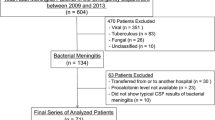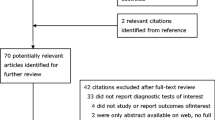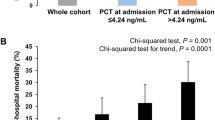Abstract
Patients with meningococcal disease who seek medical attention can create a diagnostic dilemma for clinicians due to the nonspecific nature of the disease’s presentation. This study assesses the diagnostic accuracy of procalcitonin levels in the setting of meningococcal disease. Two emergency department cohorts (A and B) were studied between 2002 and 2005, during the current epidemic of serogroup B meningococcal disease in New Zealand. Cohort A consisted of 171 patients, all with confirmed meningococcal disease (84 children, 87 adults). Cohort B consisted of a large (n=1,524) consecutively recruited population of febrile patients who presented to the emergency department, 28 of whom had confirmed meningococcal disease. Within the meningococcal disease cohort (cohort A), the geometric mean procalcitonin level was 9.9 ng/ml, with levels being higher in children than in adults (21.6 vs. 4.6 ng/ml, p=0.01). The overall sensitivity of elevated procalcitonin, using a cutoff of 2.0 ng/ml in children and 0.5 ng/ml in adults, was 0.93 (95%CI: 0.88–0.96). Despite the higher cutoff level for paediatric patients, a trend towards greater sensitivity existed in children (0.96 vs. 0.90; p=0.08). Elevated procalcitonin was correlated with whole blood meningococcal load (r=0.50) and Glasgow Meningococcal Sepsis Prognostic Score (r=0.40). Within the cohort of patients who were febrile on presentation (cohort B), the specificity of elevated procalcitonin in meningococcal disease was 0.85 (95% CI: 0.83–0.87), the positive and negative likelihood ratios were 6.1 and 0.08, respectively, and the sensitivity of elevated procalcitonin (0.93; 95% CI: 0.76–0.99) was corroborated. Measurement of procalcitonin is a useful tool in patients with nonspecific febrile illnesses when the possibility of meningococcal disease is present. The diagnostic accuracy surpasses that of current early laboratory markers, allowing results to be used to guide decisions about patient management.

Similar content being viewed by others
References
Herrick W (1919) Extrameningeal meningococcus infections. Arch Intern Med 23:409–418
Wells LC, Smith JC, Weston VC, Collier J, Rutter N (2001) The child with a non-blanching rash: how likely is meningococcal disease? Arch Dis Child 85:218–222
Wilks D, Lever AM (1996) Reasons for delay in administration of antibiotics to patients with meningitis and meningococcaemia. J Infect 32:49–51
Riordan FA, Thomson AP, Sills JA, Hart CA (1996) Who spots the spots? Diagnosis and treatment of early meningococcal disease in children. BMJ 313:1255–1256
Nadel S, Britlo J, Boey R, Maconochie I, Habibi P, Levin M (1998) Avoidable deficiencies in the delivery of health care to children with meningococcal disease. J Accid Emerg Med 15:298–303
Dashefsky B, Teele D, Klein J (1983) Unsuspected meningococcemia. J Pediatr 102:69–72
Martin D, McDowell R, Sneyd E, Baker M (2004) The epidemiology of meningococcal disease in New Zealand in 2003. New Zealand Ministry of Health, Institute of Environmental Science and Research, Wellington, pp 1–32
Gendrel D, Raymond J, Coste J, Moulin F, Lorrot M, Guerin S, Ravilly S, Lefevre H, Royer C, Lacombe C, Palmer P, Bohuon C (1999) Comparison of procalcitonin with C-reactive protein, interleukin-6 and interferon-alpha for differentiation of bacterial vs viral infections. Pediatr Infect Dis J 18:875–881
Van Rossum AMC, Wulkan RW, Oudesluys-Murphy AM (2004) Procalcitonin as an early marker of infection in neonates and children. Lancet Infect Dis 4:620–630
Simon L, Gauvin F, Amre DK, Saint-Louis P, Lacroix J (2004) Serum procalcitonin and C-reactive protein levels as markers of bacterial infection: a systematic review and meta-analysis. Clin Infect Dis 39:206–217
Carrol ED, Thomson AP, Hart CA (2002) Procalcitonin as a marker of sepsis. Int J Antimicrob Agents 20:1–9
Dandona P, Nix D, Wilson MF, Aljada A, Love J, Assicot M, Bohuon C (1994) Procalcitonin increase after endotoxin injection in normal subjects. J Clin Endocrinol Metab 79:1605–1608
Oberhoffer M, Karzai W, Meier-Hellmann A, Bogel D, Fassbinder J, Reinhart K (1999) Sensitivity and specificity of various markers of inflammation for the prediction of tumour necrosis factor-alpha and interleukin-6 in patients with sepsis. Crit Care Med 27:1814–1818
Viallon A, Zeni F, Lambert C, Pozzetto B, Tardy B, Venet C, Bertran JC (1999) High sensitivity and specificity of serum procalcitonin levels in adults with bacterial meningitis. Clin Infect Dis 28:1313–1316
Bugden SA, Coles C, Mills GD (2004) The potential role of procalcitonin in the emergency department management of febrile young adults during a sustained meningococcal epidemic. Emerg Med Austral 16:114–119
Corless CE, Guiver M, Borrow R, Edwards-Jones V, Fox AJ, Kaczmarski EB (2001) Simultaneous detection of Neisseria meningitidis, Haemophilus influenzae, and Streptococcus pneumoniae in suspected cases of meningitis and septicemia using real-time PCR. J Clin Microbiol 39:1553–1558
Meisner M (2000) Procalcitonin. A new, innovative infection parameter. Biochemical and clinical aspects. Thieme, Stuttgart, p 180
Derkx HH, van den Hoek J, Redekop WK, Bijlmer RP, van Deventer SJ, Bossuyt PM (1996) Meningococcal disease: a comparison of eight severity scores in 125 children. Intensive Care Med 22:1433–1441
Lopez AF, Cubells CL, Garcia JJG, Pou JF (2003) Procalcitonin in pediatric emergency departments for the early diagnosis of invasive bacterial infections in febrile infants: results of a multicentre study and utility of a rapid qualitative test for this marker. Pediatr Infect Dis J 22:895–903
Carrol ED, Newland P, Riordan FA, Thomson AP, Curtis N, Hart CA (2002) Procalcitonin as a diagnostic marker of meningococcal disease in children presenting with fever and a rash. Arch Dis Child 86:282–285
Van der Kaay DC, de Kleijn ED, de Rijke YB, Hop WC, de Groot R, Hazelzet JA (2002) Procalcitonin as a prognostic marker in meningococcal disease. Intensive Care Med 28:1606–1612
Casado-Flores J, Blanco-Quiros A, Asensio J, Arranz E, Garrote JA, Nieto M (2003) Serum procalcitonin in children with suspected sepsis: a comparison with C-reactive protein and neutrophil count. Pediatr Crit Care Med 4:190–195
Hatherill M, Tibby SM, Sykes K, Turner C, Murdoch IA (1999) Diagnostic markers of infection: comparison of procalcitonin with C-reactive protein and leukocyte count. Arch Dis Child 81:417–421
Leclerc F, Leteurtre S, Noizet O, Dorkenoo A, Sadik A, Cremer R, Fourier C (2002) Procalcitonin as a prognostic marker in children with meningococcal septic shock. Arch Dis Child 87:450
Karabocuoglu M, Kaya O (2000) Plasma procalcitonin levels correlated with the severity of systemic meningococcal disease in children. Crit Care Med 28(Suppl):A170
Marzouk O, Bestwick K, Thomson APJ, Sills JA, Hart CA (1993) Variation in serum C-reactive protein across the clinical spectrum of meningococcal disease. Acta Paediatr 82:729–733
Kornelisse RF, Hazelzet JA, Hop WC, Spanjaard L, Suur MH, van der Voort E, de Groot R (1997) Meningococcal septic shock in children: clinical and laboratory features, outcome, and development of a prognostic score. Clin Infect Dis 25:640–646
Brunkhorst FM, Heinz U, Forycki ZF (1998) Kinetics of procalcitonin in iatrogenic sepsis. Intensive Care Med 24:888–892
Nylen E, Muller B, Becker KL, Snider R (2004) The future diagnostic role of procalcitonin levels: the need for improved sensitivity. Clin Infect Dis 36:823–824
Christ-Crain M, Jaccard-Stolz D, Bingisser R, Gencay MM, Huber PR, Tamm M, Muller B (2004) Effect of procalcitonin-guided treatment on antibiotic use and outcome in lower respiratory tract infections: cluster-randomised, single-blinded intervention trial. Lancet 363:600–607
Carrol ED, Newland P, Thomson APJ, Hart CA (2005) Prognostic value of procalcitonin in children with meningococcal sepsis. Crit Care Med 33:224–225
Hackett SJ, Guiver M, Marsh J, Sills JA, Thomson APJ, Kaczmarski EB, Hart CA (2002) Meningococcal bacterial DNA load at presentation correlates with disease severity. Arch Dis Child 86:44–46
Acknowledgements
We thank the patients with MCD and their families for agreeing to participate in this study, the public health units who arranged for the consent and timely notification of patients to the coordinating site, and the Waikato Hospital biochemistry department for undertaking the LUMItest PCT testing.
The Waikato Medical Research Foundation and the Waikato Hospital Respiratory Research Unit provided funding for this study. The Waikato District Health Board funded summer studentships for H Lala and M Oehley (medical students). The funding sources had no role in design, analysis, or the writing of the study report.
Author information
Authors and Affiliations
Corresponding author
Rights and permissions
About this article
Cite this article
Mills, G.D., Lala, H.M., Oehley, M.R. et al. Elevated procalcitonin as a diagnostic marker in meningococcal disease. Eur J Clin Microbiol Infect Dis 25, 501–509 (2006). https://doi.org/10.1007/s10096-006-0179-y
Published:
Issue Date:
DOI: https://doi.org/10.1007/s10096-006-0179-y




